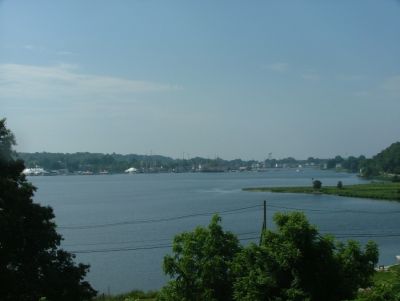A lot of wooden boats
 We
left
New London early, and planed to drive straight on to
Boston, Massachusetts, taking
the
interstate
all the way. We wanted to get to Boston early, so we
had time to look at the city that very afternoon.
We therefore got on I-95 as early as possible, and
drove north.
We had not driven more than about 10 miles though,
when we saw a signpost, advertising a "scenic
overview".
We decided to take a look, and it turned out
that from the overview, we could see a portion of Mystick River and the city Mystic. If anyone
wonders
about the name Mystic, there is no mystery to it.
The name origins from a word from a now extinct
Native American language (The
Mohegan-Montauk-Narragansett). The word "missituck"
simply means "the river
that is so big that it has waves.
We
left
New London early, and planed to drive straight on to
Boston, Massachusetts, taking
the
interstate
all the way. We wanted to get to Boston early, so we
had time to look at the city that very afternoon.
We therefore got on I-95 as early as possible, and
drove north.
We had not driven more than about 10 miles though,
when we saw a signpost, advertising a "scenic
overview".
We decided to take a look, and it turned out
that from the overview, we could see a portion of Mystick River and the city Mystic. If anyone
wonders
about the name Mystic, there is no mystery to it.
The name origins from a word from a now extinct
Native American language (The
Mohegan-Montauk-Narragansett). The word "missituck"
simply means "the river
that is so big that it has waves.
The view was so interesting that we decided to
leave the highway in spite of our earlier decision,
and drive down to town so we did.
When we got there, we followed the signposts to
Mystic Seaport, an "open air museum of ships",
actually this is the world's largest maritime
museum.
The museum is built as a seafaring town from the
1800s, and several large and small vessels are
located in the museum, which also includes
workshops, such as ship building workshops, a
blacksmith shop and more.
We found a parking lot and bought a ticket to the
museum.
When we entered, it appeared that we visited the
place on the last day of the annual wooden boat
festival, and it meant that there were even
more old wooden vessels than usual - most of them
were still in use and in
private ownership.
We walked around and looked at the ships and the
many workshops.
Among the big ships are Charles W. Morgan, from
1841, America's only remaining wooden whaling ship.
The ship did not catch whales, this was done by
smaller whale boats, which the whaling ship carried
around, hanging from davits. When whales were observed
the whale boats were lowered from the davits, and
from these small vessels the hunting and killing of
whales were carried out. The whaling ship itself
functioned as a depot ship, a whaling factory and
whale oil storage.
If you are interested in how these things went on,
Herman Melville's Moby Dick is a good, but somewhat
"slow" starting point.
Herman Melville himself had sailed on whaling ships, so he was familiar with
the business.
Another large sailing ship is J.P. Conrad, built in
1882 under the name Georg Stage, and used as as
Danish sailtraining vessel until 1934 when it was
replaced by the current Georg Stage, built of steel.
These two ships, as well as several others are
located permanently in Mystic Seaport.
Among the other ships is a
 reconstruction
of the slave ship Amistad, which is probably best
known from the namesake movie, and the remains of
the schooner Australia, who suffered a stormy life,
partly as a blockade runner during the American
Civil War.
The boat has been restored several times but is now left like a wreckage with
open hull, so you can see how the ship is
constructed.
reconstruction
of the slave ship Amistad, which is probably best
known from the namesake movie, and the remains of
the schooner Australia, who suffered a stormy life,
partly as a blockade runner during the American
Civil War.
The boat has been restored several times but is now left like a wreckage with
open hull, so you can see how the ship is
constructed.
We also visited a building, housing a model that
showed how the city had looked about 1870, and we
saw the preservation shipyard which works to preserve
and restore old wooden boats.
Furthermore, we walked through some of the workshops, including a brass
foundry.
In honor of the wooden ships festival numerous stalls
was set up, from which were sold everything between heaven and
earth.
I bought some beef jerky spiced with pepper, and it was
pretty hot!
Dorte bought herself a hat made from seaweed. The hat
could survive being wet, pinched, curled up and so
on, and it stuck on the head even in windy
conditions. As usual she never wore it again!
After our visit to the museum, we returned to the interstate and continued to Boston with no further interruptions. We stayed at the Hyatt Regency in Cambridge, and had n trouble finding the hotel, but a little trouble getting there, as a lot of streets were closed due to a bike race, but eventually we managed and got ourselves a room with a view over Charles River and Boston on the opposite bank.
- Return to New
Enlgand and New York -
- Return to Travel Stories -